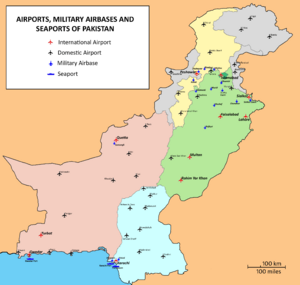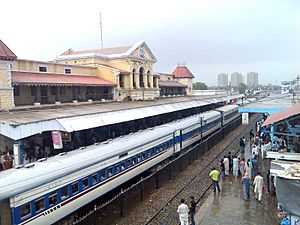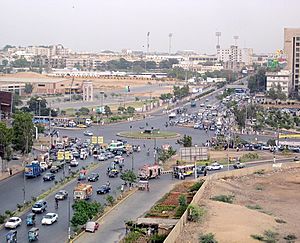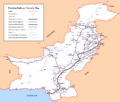Transportation in Pakistan facts for kids
Pakistan is a big country with over 170 million people! To help everyone get around and move goods, it has a large and diverse transportation system. This system is always growing and improving. Building new airports, roads, and railway lines also creates many jobs for people.
Contents
Rail Travel in Pakistan
Trains are a very important way to travel and move goods in Pakistan. The government-run company, Pakistan Railways, manages all the train services. They help move a lot of people and many different products across the country.
Trains Across Pakistan
The railway network in Pakistan is about 8,163 kilometers (about 5,072 miles) long. Most of this, 7,718 kilometers (about 4,796 miles), uses a wide track called "broad gauge." A smaller part, 293 kilometers (about 182 miles), has electric trains. The rest, 445 kilometers (about 277 miles), uses "narrow gauge" tracks.
Pakistan Railways also runs special trains for different events. A special team of 12,000 people handles freight, which means moving goods. They work at over 200 train stations. This team helps move farm products, factory goods, and imported items like wheat, coal, and sugar from places like the Port of Karachi and Port Qasim to other parts of the country.
City Trains (Metros)
The Karachi Circular Railway started running in the early 1940s. It is the only city train system working in Pakistan right now. In 1976, there were plans to build an underground metro system in Karachi, but it didn't happen. The Lahore Metro also helps people travel from Gagu Matta to Shahadara.
International Train Connections
Pakistan is working to connect its train lines with other countries.
- Connecting with Iran: There is a wide-track railway line that goes from Zahedan in Iran to Quetta in Pakistan. Iran has also finished a standard-track line from Zahedan to Kerman in central Iran, connecting to the rest of their train network. Pakistan and Iran signed an agreement in 2007 to finish connecting their lines. Now, trains can travel between the two countries at Zahedan, but they have to switch tracks because Iran uses a different size track than Pakistan.
- Connecting with Afghanistan: Right now, Afghanistan does not have a railway network. However, Pakistan Rail has offered to help Afghanistan build one in three steps. First, a line would go from Chaman in Pakistan to Spin Boldak in Afghanistan. Second, it would extend to Kandahar. Third, it would reach Herat. From Herat, the line could even go to Khushka in Turkmenistan. This would connect Pakistan's wide tracks with Central Asia's narrower tracks. There are also plans to connect the port city of Gwadar in Pakistan to Central Asia through this new line.
- Connecting with China: There is no train link with China yet. But in 2007, studies began for a possible train line from Havelian in Pakistan to Kashgar in China. This line would cross the Khunjerab Pass, which is very high up in the mountains (4,730 meters or 15,518 feet!). The total distance would be about 750 kilometers (about 466 miles).
- Connecting with Turkey: There have been talks about a passenger train service connecting Istanbul (Turkey), Tehran (Iran), and Islamabad (Pakistan). In 2009, a special train carrying containers started its journey from Islamabad to Istanbul. This train carried about 750 tons of goods and traveled 6,500 kilometers (about 4,039 miles) in two weeks. After this test, there are hopes for a passenger train. This route could eventually connect Pakistan to Europe and Central Asia for both goods and people.
Road Travel in Pakistan
Roads are another very important way to travel in Pakistan. In the 1990s, Pakistan started a big project to rebuild its main roads, called National Highways. These roads connect important cities, ports, and business centers. The National Highway Authority (NHA) is in charge of keeping all these roads in good condition.
Important National Highways
- The Makran Coastal Highway: This road runs along the coast of the Sindh and Balochistan provinces. It connects the port cities of Karachi and Gwadar. Thanks to this new highway, travel time between these cities has been cut down to just six or seven hours. It was built to make travel easier in southern Balochistan.
- The Karakoram Highway: This is known as the highest paved international road in the world! It connects China with Pakistan by crossing the Karakoram mountain range through the Khunjerab Pass.
- The Grand Trunk Road: Often called the GT Road, this is one of the oldest and longest main roads in South Asia. For hundreds of years, it has linked the eastern and western parts of South Asia. It starts in western Bengal, goes across northern India, and ends in Peshawar, Pakistan.
- The Silk Road: This was a huge network of trade routes across Asia. It connected East, South, and Western Asia with places around the Mediterranean Sea, including North Africa and Europe. A part of this historic route passes through the middle of Pakistan, going through cities like Peshawar, Taxila, and Multan.
Motorways (Expressways)
Building motorways started in the early 1990s. The goal was to create a top-quality road network and reduce traffic on the busy national highways. The M2 motorway was the first to be finished in 1998. It connects the cities of Islamabad and Lahore. Many new motorways have opened since then, including the M1 and M3 motorways.
Pakistan has a total of about 257,683 kilometers (about 160,117 miles) of roads. About 152,033 kilometers (about 94,469 miles) are paved, including 339 kilometers (about 211 miles) of expressways. The rest are unpaved roads. In 2004, there were about 4.2 million vehicles on the roads, with 250,000 of them being commercial vehicles like trucks and buses.
Images for kids

























